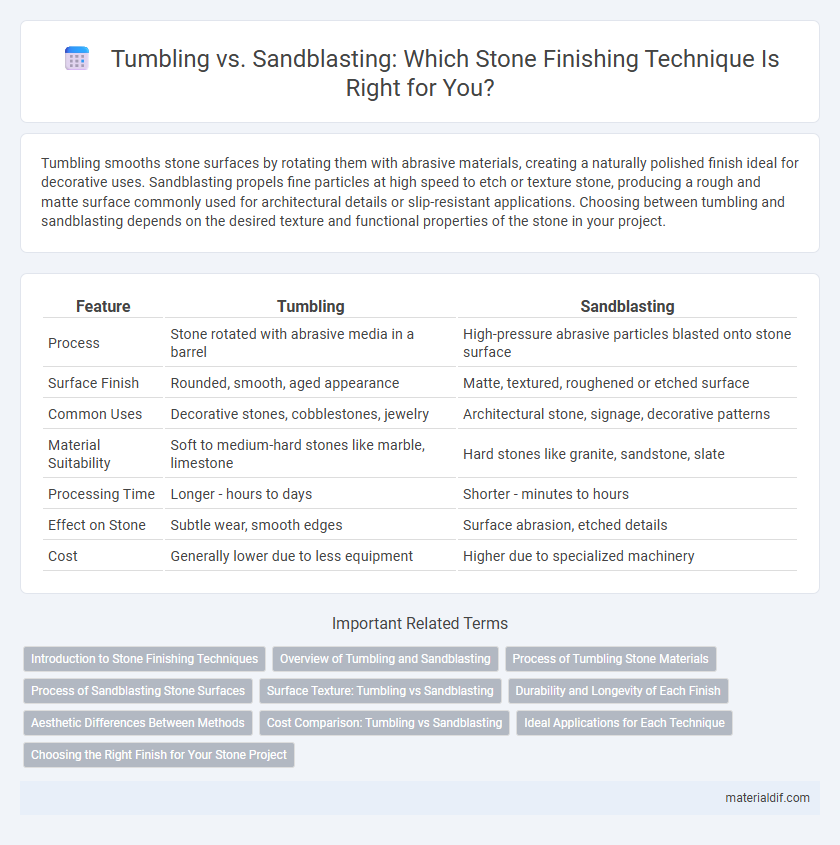Tumbling smooths stone surfaces by rotating them with abrasive materials, creating a naturally polished finish ideal for decorative uses. Sandblasting propels fine particles at high speed to etch or texture stone, producing a rough and matte surface commonly used for architectural details or slip-resistant applications. Choosing between tumbling and sandblasting depends on the desired texture and functional properties of the stone in your project.
Table of Comparison
| Feature | Tumbling | Sandblasting |
|---|---|---|
| Process | Stone rotated with abrasive media in a barrel | High-pressure abrasive particles blasted onto stone surface |
| Surface Finish | Rounded, smooth, aged appearance | Matte, textured, roughened or etched surface |
| Common Uses | Decorative stones, cobblestones, jewelry | Architectural stone, signage, decorative patterns |
| Material Suitability | Soft to medium-hard stones like marble, limestone | Hard stones like granite, sandstone, slate |
| Processing Time | Longer - hours to days | Shorter - minutes to hours |
| Effect on Stone | Subtle wear, smooth edges | Surface abrasion, etched details |
| Cost | Generally lower due to less equipment | Higher due to specialized machinery |
Introduction to Stone Finishing Techniques
Stone finishing techniques like tumbling and sandblasting enhance surface texture and durability, serving distinct aesthetic and functional purposes. Tumbling creates a smooth, rounded, and weathered effect by agitating stone with abrasive materials, commonly used for cobblestones and decorative pavers. Sandblasting produces a rough, matte finish by propelling sand particles against the stone surface, improving slip resistance and highlighting natural patterns.
Overview of Tumbling and Sandblasting
Tumbling involves rotating stones in a barrel with abrasive grit to smooth and polish surfaces, creating a natural, rounded appearance ideal for jewelry and decorative items. Sandblasting uses high-pressure air to blast fine sand particles at the stone, producing a textured or matte finish commonly applied to monuments and architectural elements. Both techniques enhance stone aesthetics but differ in texture outcome and application methods.
Process of Tumbling Stone Materials
Tumbling stone materials involves placing rough stones into a rotating barrel filled with abrasive grit and water, which smooths and polishes their surfaces through continuous friction over several days or weeks. This natural abrasion process gradually rounds edges and enhances the stone's texture, creating a weathered, antique appearance without altering the stone's inherent color. Tumbling is commonly used for softer stones like marble, limestone, and sandstone, providing a tactile finish suited for decorative applications and landscaping.
Process of Sandblasting Stone Surfaces
Sandblasting stone surfaces involves propelling fine abrasive particles at high velocity to erode and texture the stone, creating a uniform, matte finish. This process enhances slip resistance and highlights the natural grain of materials such as granite or limestone. Controlled pressure and abrasive media selection are crucial to achieving the desired surface roughness without damaging the structural integrity of the stone.
Surface Texture: Tumbling vs Sandblasting
Tumbling creates a smooth, rounded surface texture by polishing stones with abrasive materials in a rotating drum, resulting in a more natural, worn appearance. Sandblasting produces a rougher, matte texture by blasting high-pressure sand particles onto the stone's surface, enhancing its slip resistance and aesthetic contrast. Selecting between tumbling and sandblasting depends on the desired tactile feel and visual style for architectural or landscaping projects.
Durability and Longevity of Each Finish
Tumbling produces a worn, textured surface that enhances stone durability by smoothing sharp edges, reducing chipping and surface damage over time. Sandblasting creates a rough, matte finish that increases grip and weather resistance, but it can expose the stone to gradual surface erosion in harsh environments. Overall, tumbling offers superior longevity for high-traffic areas, while sandblasting suits decorative applications requiring slip resistance and moderate durability.
Aesthetic Differences Between Methods
Tumbling produces a smooth, rounded finish that enhances the natural color variations and textures of stone, creating a soft, weathered appearance ideal for rustic designs. Sandblasting creates a rough, matte surface with a uniform texture that highlights intricate details and gives a modern, industrial look without altering the stone's original color. Both methods uniquely affect the stone's aesthetic, with tumbling emphasizing natural character and sandblasting focusing on precise pattern definition.
Cost Comparison: Tumbling vs Sandblasting
Tumbling typically incurs lower initial costs due to simpler equipment and reduced labor intensity, making it a budget-friendly option for smaller stone pieces or decorative finishes. Sandblasting, while more expensive upfront because of specialized machinery and higher maintenance, offers quicker processing times and superior precision for detailed stone surfaces. Choosing between tumbling and sandblasting depends on project scale and desired finish quality, with tumbling excelling in cost-efficiency and sandblasting delivering enhanced customization at a higher price point.
Ideal Applications for Each Technique
Tumbling is ideal for achieving a smooth, rounded finish on stones used in jewelry, landscaping, and decorative projects, enhancing their natural texture and color. Sandblasting suits applications requiring precise surface etching or a matte, textured finish on architectural stone, monuments, or signage to improve visual contrast. Choosing the correct technique depends on whether the project demands gentle polishing or detailed surface modification for functional or aesthetic purposes.
Choosing the Right Finish for Your Stone Project
Tumbling provides a naturally aged, weathered look by smoothing and rounding stone edges, ideal for rustic or antique finishes, while sandblasting creates a textured, matte surface by blasting fine sand particles, suitable for sharp, modern designs. The choice depends on the desired aesthetic and functional needs, with tumbling enhancing softness and sandblasting offering durability against wear. Consider the stone type and project environment because softer stones respond better to tumbling, whereas harder stones are more durable with sandblasted finishes.
Tumbling vs Sandblasting Infographic

 materialdif.com
materialdif.com